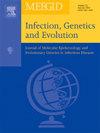The presence of genes encoding carbapenem-hydrolyzing oxacillinase and lack of carbapenem resistance in non-baumannii Acinetobacter misidentified as Acinetobacter baumannii causing bloodstream infections in a tertiary hospital over a 3-year period
IF 2.6
4区 医学
Q3 INFECTIOUS DISEASES
引用次数: 0
Abstract
Objective
This study aims to analyze the genomic and clinical characteristics of Non-baumannii Acinetobacter strains misidentified as A. baumannii, causing bloodstream infections (BSIs) in our hospital.
Materials and methods
Whole genome sequencing was performed and average nucleotide identity (ANI) was analyzed. Susceptibility testing was conducted using micro-broth methods. The distribution of antimicrobial resistance genes (ARGs) and mobile genetic elements (MGEs) was examined using online software tools. The prevalence of virulence factors (VFs) was investigated through nucleotide coding sequence comparisons. Genetic structures of blaOXA genes were analyzed by Gcluster software. Clinical information was collected from electronic medical records for patient characterization.
Results
ANI analysis identified five strains as Acinetobacter pittii, with the remaining four identified as A. geminorum, A. nosocomialis, A. soli and A. bereziniae. The GC content of all isolates was less than 38.9 % except for A. soli 16,294. All Non-baumannii Acinetobacter strains were relatively susceptible to antibiotics, except for one A. pittii isolate. Nine blaOXA variants were identified in seven isolates, with two isolates co-carrying 2 different types of blaOXA. Twenty-four insertion sequences (ISs) were identified, with ISAba and IS17 being the primary ISs. Five A. pittii isolates shared the same genetic structures around blaOXA. Genes related to adherence, immune modulation, and nutritional/metabolic factors were the most frequent. Few VFs were detected in A. soli 16,294 and A.bereziniae 14,325.
Conclusions
The presence of carbapenem hydrolyzing oxacillinase encoding genes did not confer carbapenem resistance, possibly due to the lack of ISs in the blaOXA flanking sequences. Different blaOXA variants within distinct strains shared the same genetic structures, suggesting potential for multidrug resistance development, which warrants our attention.
在一家三级医院中,被误认为鲍曼不动杆菌的非鲍曼不动杆菌存在编码碳青霉烯水解氧青霉烯酶的基因,且对碳青霉烯类无耐药性。
研究目的本研究旨在分析在我院引起血流感染(BSI)的被误认为鲍曼不动杆菌的非鲍曼不动杆菌菌株的基因组和临床特征:进行全基因组测序并分析平均核苷酸同一性(ANI)。采用微滴法进行药敏试验。使用在线软件工具检测了抗菌药耐药基因(ARGs)和移动遗传因子(MGEs)的分布。通过核苷酸编码序列比较研究了毒力因子(VFs)的流行情况。使用 Gcluster 软件分析了 blaOXA 基因的遗传结构。从电子病历中收集了临床信息,以确定患者的特征:结果:ANI分析确定5株为皮氏不动杆菌,其余4株分别为A. geminorum、A. nosocomialis、A. soli和A. bereziniae。除了 A. soli 16,294 外,所有分离物的 GC 含量都低于 38.9%。除了一个皮氏不动杆菌分离株外,所有非鲍曼不动杆菌菌株对抗生素都相对敏感。在 7 个分离株中发现了 9 种 blaOXA 变体,其中 2 个分离株同时携带 2 种不同类型的 blaOXA。鉴定出 24 个插入序列(ISs),其中 ISAba 和 IS17 是主要的 ISs。五个 A. pittii 分离物共享围绕 blaOXA 的相同基因结构。与粘附性、免疫调节和营养/代谢因素有关的基因最为常见。在A.soli 16 294和A.bereziniae 14 325中检测到的VFs很少:结论:碳青霉烯水解氧青霉烯酶编码基因的存在并不会产生碳青霉烯耐药性,这可能是由于 blaOXA 侧翼序列中缺乏 ISs。不同菌株中的不同 blaOXA 变体具有相同的遗传结构,这表明可能会产生多重耐药性,值得我们关注。
本文章由计算机程序翻译,如有差异,请以英文原文为准。
求助全文
约1分钟内获得全文
求助全文
来源期刊

Infection Genetics and Evolution
医学-传染病学
CiteScore
8.40
自引率
0.00%
发文量
215
审稿时长
82 days
期刊介绍:
(aka Journal of Molecular Epidemiology and Evolutionary Genetics of Infectious Diseases -- MEEGID)
Infectious diseases constitute one of the main challenges to medical science in the coming century. The impressive development of molecular megatechnologies and of bioinformatics have greatly increased our knowledge of the evolution, transmission and pathogenicity of infectious diseases. Research has shown that host susceptibility to many infectious diseases has a genetic basis. Furthermore, much is now known on the molecular epidemiology, evolution and virulence of pathogenic agents, as well as their resistance to drugs, vaccines, and antibiotics. Equally, research on the genetics of disease vectors has greatly improved our understanding of their systematics, has increased our capacity to identify target populations for control or intervention, and has provided detailed information on the mechanisms of insecticide resistance.
However, the genetics and evolutionary biology of hosts, pathogens and vectors have tended to develop as three separate fields of research. This artificial compartmentalisation is of concern due to our growing appreciation of the strong co-evolutionary interactions among hosts, pathogens and vectors.
Infection, Genetics and Evolution and its companion congress [MEEGID](http://www.meegidconference.com/) (for Molecular Epidemiology and Evolutionary Genetics of Infectious Diseases) are the main forum acting for the cross-fertilization between evolutionary science and biomedical research on infectious diseases.
Infection, Genetics and Evolution is the only journal that welcomes articles dealing with the genetics and evolutionary biology of hosts, pathogens and vectors, and coevolution processes among them in relation to infection and disease manifestation. All infectious models enter the scope of the journal, including pathogens of humans, animals and plants, either parasites, fungi, bacteria, viruses or prions. The journal welcomes articles dealing with genetics, population genetics, genomics, postgenomics, gene expression, evolutionary biology, population dynamics, mathematical modeling and bioinformatics. We also provide many author benefits, such as free PDFs, a liberal copyright policy, special discounts on Elsevier publications and much more. Please click here for more information on our author services .
 求助内容:
求助内容: 应助结果提醒方式:
应助结果提醒方式:


